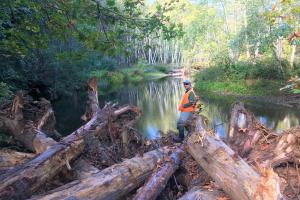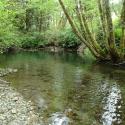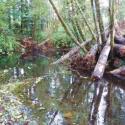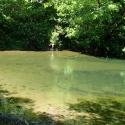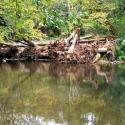(707) 839-5130 | Contact Us
Little River Coho Habitat Enhancement Project, Phases I & II
Pacific Watershed Associates collaboratively designed and implemented the instream placement of large wood in order to restore salmonid habitat in Little River. This is a case example of our North Coast Fisheries and Aquatic Habitat Restoration Projects: Instream Large Wood Habitat Restoration.
Pacific Watershed Associates (PWA), Pacific Coast Fish, Wildlife and Wetlands Restoration Association (PCFWWRA), Green Diamond Resource Company (GDRC), and California Department of Fish and Wildlife (CDFW) have collaborated on multiple fisheries restoration projects throughout our North Coast watersheds. Many of these projects have been funded through the CDFW Fisheries Restoration Grant Program (FRGP). These projects are intended to provide a direct benefit to imperiled coastal anadromous fisheries, including threatened coho salmon, while also contributing jobs and economic development within the North Coast of California.
Two such project examples enhanced salmonid habitat by creating 24 woven log habitat structures along 1.5 miles of Little River in Humboldt County.
We utilized a cost-effective approach of accelerating large wood recruitment that was designed to mimic the form and function of existing, naturally formed large wood structures in the stream system, and to be self-sustaining by continuing to rack wood that moves through the selected channel reaches. This approach utilized constructed, anchored wood, and non-anchored wood that enhanced flatwater habitat types and shallow pools through increasing logjam and woody debris quantity and complexity, thereby deepening pools, increasing sinuosity, and providing cover and protection from predators, spawning gravels, cool water, low velocity refugia, and food resources for fish. Project work bolstered existing log jams and their associated geomorphic features within the stream reach, as well as created new features.
The project team coordinated the selection and harvest of 382 logs and rootwads for habitat enhancement as a collaborative effort with the staff of GDRC; PCFWWRA; and PWA. Trees were felled and toppled (with root wads) from nearby GDRC forest lands, yarded by bulldozer, loaded on log trucks using an excavator, and hauled to the roads nearest the instream work sites.
On-the-ground construction of the instream wood jams and log structures was supervised, documented, and monitored by PWA. Implementation of the instream work was conducted during the summer and fall of 2015 to 2017. The large wood habitat features were constructed using an excavator, with a bulldozer moving logs to each of the work sites. The excavator mechanically placed logs and constructed the various types of log jams and wood structures as designed by, and under supervision of, PWA scientists. Once installation with heavy equipment was complete, laborers anchored the large wood structures utilizing rebar and bolts, as per methods described in the California Department of Fish and Game’s California Salmonid Stream Habitat Restoration Manual (2010). All features were documented with photo points from multiple angles prior to construction and after construction. Some time lapse videos were taken during construction and during the first winter flows to document performance.
The projects have been successful at meeting project objectives. Overall, the structures have performed well, scouring new pools, sorting gravels, improving cover, increasing habitat complexity, and providing refugia from high flows for threatened overwintering juvenile salmonids. Additionally, salmonids have been observed spawning within the fluvial geomorphic features (gravel deposits) created by the projects.
Funding for these projects was provided by California Department of Fish and Wildlife, Fisheries Restoration Grant Program Agreement Numbers P1310504 and P1410550.
For any questions regarding this project or related fisheries restoration issues feel free to contact:
Tom Leroy, Senior Engineering Geologist (PWA) 707-839-5130
Mitch Farro, Projects Manager (PCFWWRA) 707-839-5664
- 1 of 26
- Projects:
- next ›

